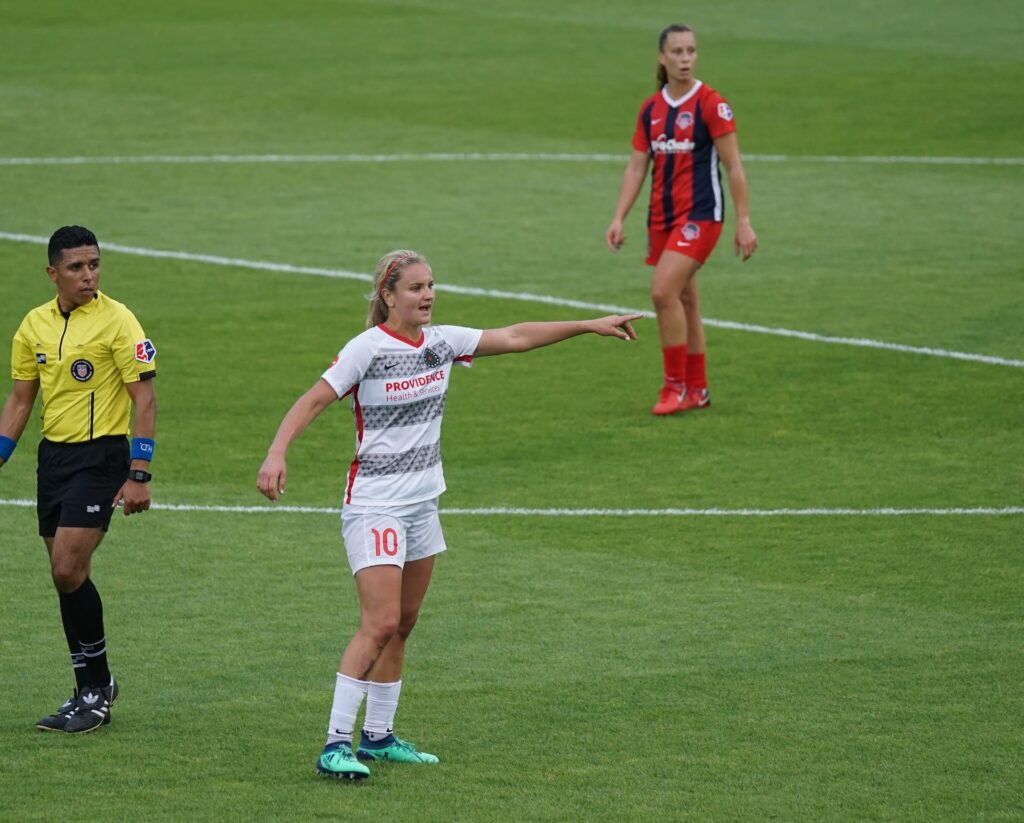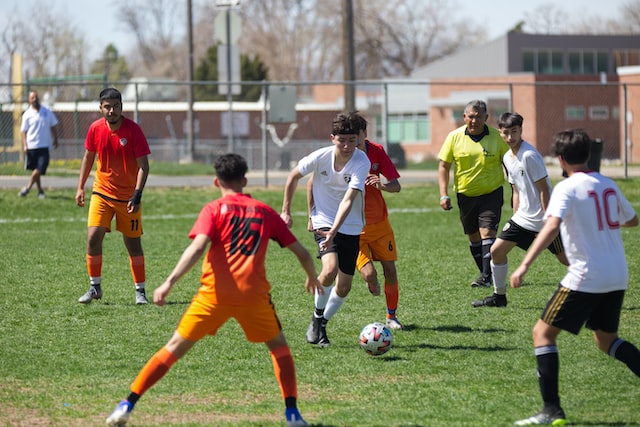They might be the scorn of so many soccer fans, but without them, we’d have no beautiful game.
Yes, I’m of course talking about referees. The rule enforcers and arbitrators don’t often get the credit they deserve. Fans tend to remember that one moment the referee missed instead of the countless correct decisions they made throughout the course of the game.
Let’s examine what the role of the referee is in soccer, along with what else is used in the officiating process.
What is the referee in soccer?
The referee is an independent figure who officiates the game to penalize any rule infringements and ensures order.
Each referee will have assistant referees who they can confer with, but the decision of the referee is final.
The officiators are typically supplied with a whistle, yellow and red cards, a notebook and pen, a device linked to goal-line technology, a coin for the toss, vanishing spray, a distinctive uniform, and a watch.
Do soccer referees get paid?

Regarding professional soccer, referees do, in fact, get paid. The further down a soccer pyramid you go, the less a referee will be paid.
In the English Premier League, referees receive a base salary of around £40,000 (roughly $45,100). An extra £1,150 sum on top of that is given to referees for every Premier League match they officiate.
Other major leagues in Europe don’t appear to pay referees on a salary basis, instead opting for fees per match. While the security of a minimum income is nice for English referees, Spanish officials can earn more per game they are in charge of, potentially taking their earnings beyond their English counterparts.
What is the assistant referee in soccer?
Assistant referees are the two officials who operate just off the touchlines. If you’re looking at a pitch from a birdseye view, one official will run along the top-right side of the pitch while the runs along the bottom-left side.
Assistant referees cover half of the pitch each, so, if we look at that birdseye view of the field again, if every player is in the upper half of the pitch, the official running the line of the lower half of the pitch would stop at the halfway line until players cross back into the lower zone, and vice versa.
They’re tasked with running alongside the last defender, which ensures the best view of whether an attacker is offside or not.
What is the VAR (Video Assistant Referee) in soccer?
The Video Assistant Referee (VAR) is a match official who immediately reviews critical decisions made by the on-field referee or assistant referees to assess whether they were correct.
If the VAR suspects that there might have been an error in a subjective call, such as intent in a handball decision or reckless endangerment in a tackle, they will ask the referee to go over to the pitchside monitor and see the replay for themselves before making the ultimate decision.
For more objective matters like offsides, the VAR’s decision is final.
The VAR routinely checks goals, penalty decisions, and straight red cards to ensure the correct decision has been made.
The VAR system is used in every major soccer league globally, with the notable exception of the Scottish Premiership (although that is due to change after the 2022 World Cup).
People often refer to the technology itself as VAR rather than the official in the video control room. This misnomer has sparked a wider debate in soccer regarding the very existence of the VAR, with many forgetting that this contemporary technology is merely the tool a person uses to make decisions.
In theory, the technology associated with the VAR works perfectly. It’s the officials who use this technology that are making the supposed errors. All the technology is doing is giving the officials a chance to see these incidents again as the viewers at home can.
The use of the system has certainly had its teething problems. The microscopic zooming in on somebody’s armpit when making offside calls was frankly laughable. Thankfully, many leagues have come to their senses and introduced thicker offside lines, so there will be some leniency granted to attackers.
Whether having the VAR is good for the sport, however, is another conversation.
From a fan’s perspective, the unaccountability of the VAR doesn’t sit right with many.
There are calls for the VAR to have a microphone so that fans in the stadium or watching the game on TV can at least understand why the officials have made the call they have.
The unrivaled outbursts of ecstasy when your team scores have been somewhat dampened because, in the back of your mind, you know there is somebody looking for a reason to rule the goal out.
Does this ruin the fan experience? Maybe, but with the stakes so high regarding the outcome of matches these days, you can see why relying on one person viewing an incident at full speed raises eyebrows.
What is the fourth official in soccer?
The fourth official is an assistant referee who is based between the two managerial dugouts throughout the game.
Duties that the fourth official is expected to undertake include displaying how much added time there will be at the end of each half, signaling the shirt numbers of the players involved in substitutions, inspecting the apparel and other items on a person before they’re substituted on, and to generally mediate between the two coaching staffs.
Crucially, fourth officials also serve as substitute referees. It’s rare, but officials get injured too, so should the referee or an assistant referee pull a muscle, for example, the fourth official will replace them.
What is goal-line technology in soccer?
Goal-line technology is a device that alerts the referee to the fact that the entire ball has crossed the line and a goal should be awarded.
Prior to 2011, goal-line technology didn’t exist in soccer. Many believe that Frank Lampard’s shot, which clearly crossed the line but wasn’t given by the officials, in England’s 2010 World Cup match versus Germany was the final straw in the debate.
The current implementation of goal-line technology is highly accurate, and the graphics we see on our TV screens paint a clearer picture for the viewer.
Depending on which operating system is in use, either a series of cameras or a magnetic field detect the ball’s path and almost instantaneously decipher whether the ball has crossed the goal line.
Although, it can never be 100% accurate, as we found out in June 2020, the first Premier League game after the season’s hiatus due to the COVID-19 outbreak.
Aston Villa goalkeeper Ørjan Nyland spilled Sheffield United’s looped free-kick over the goal line by about a yard. Several Sheffield United players turned away in celebration as Nyland looked resigned to his error, but the referee didn’t point to the center circle because his watch didn’t buzz with a goal alert.
For reasons that were unclear at the time, the cameras in the stadium didn’t seem to pick up what had happened. That game finished 0-0, and Aston Villa stayed up by a point. This, however, is an extremely rare occurrence.
Do match officials in soccer still stand behind the goal?
Despite featuring in the modern laws of the game, officials behind the goals aren’t frequently seen these days.
Additional Assistant Referees (AAR) were brought in because sometimes the referee might be unsighted to an incident in the penalty area if there is a crowd of bodies or because a linesman might not accurately see whether the ball has crossed the goal-line, so this assistant would be an extra pair of eyes, essentially.
Goal-line technology and VAR have since made this officiating position redundant.
It’s important to remember as well that the cost of having assistant referees situated behind the goals is a big reason why many divisions further down the football ladder couldn’t afford these additional referees.
Recap: The match officials in soccer
Spare a thought for the referees the next time you watch a game of soccer. They don’t receive many plaudits, but they’re not there to ruin your day.
In fact, having a referee at the amateur level settles any disputes so the game can be played fairly and competitively.

